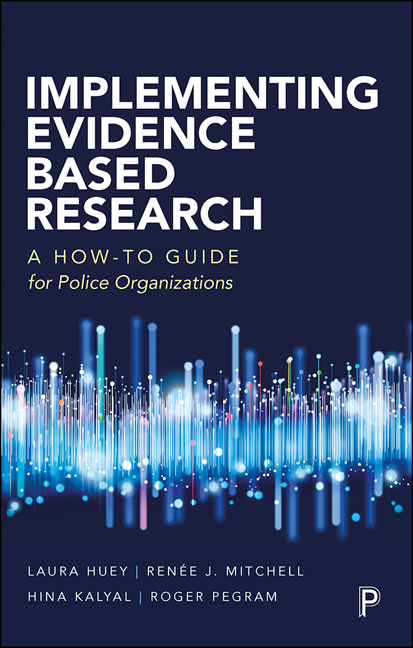Book contents
- Frontmatter
- Contents
- List of tables and figures
- Acknowledgments
- Introduction
- 1 Implementing evidence-based policing
- 2 Situating evidence-based policing
- 3 Understanding research
- 4 The individual approach
- 5 The smaller agency
- 6 The mid-sized agency
- 7 The larger agency
- 8 Generating sustainability
- 9 Resources for evidence-based practices
- Endnotes
- References
- Index
Introduction
Published online by Cambridge University Press: 05 January 2022
- Frontmatter
- Contents
- List of tables and figures
- Acknowledgments
- Introduction
- 1 Implementing evidence-based policing
- 2 Situating evidence-based policing
- 3 Understanding research
- 4 The individual approach
- 5 The smaller agency
- 6 The mid-sized agency
- 7 The larger agency
- 8 Generating sustainability
- 9 Resources for evidence-based practices
- Endnotes
- References
- Index
Summary
Okay, we’re sold. But now what? (Question asked by a police chief)
About 20 years ago, Lawrence Sherman (1998) wrote an article for the National Police Foundation in the USA that set out two important challenges:
• For police agencies: to participate in the creation and use of high-quality research to guide the development of evidencebased policy, programs and practices.
• For researchers: to craft scientific work that can be readily understood and used by police services.
The rationale? To learn from what the combination of science and police expertise can tell us ‘works’ (and what doesn’t) in relation to various aspects of public policing, from reducing burglaries to deterring gun violence.
Since Sherman's famous challenge, we’ve seen the global growth of evidence-based policing (EBP) into a movement of sorts that has spawned four Societies of Evidence-Based Policing (in the UK, Canada, the USA, and Australia and New Zealand) numbering thousands of members. There are annual conferences, training seminars, books, articles, and various tools and resources to help the budding EBP practitioner. But so far, despite various attempts at laying out some general ideas and principles (see Martin, 2018), what no one has been willing to tackle is the dreaded question posed to us after nearly every presentation or training session we’ve led: ‘How do you actually do this stuff?’
In this book, we tackle this question in a practical, nuts and bolts sort of way, offering ideas and suggestions drawn from both our own research into embedding EBP and from the broader research literature. To be clear: this is not your standard criminology book – we don't breathlessly recite all of the latest and greatest findings from criminological research (although there will be plenty of that too). Instead, our focus is on how individuals and organizations can become more evidence-based.
To become more evidence-based requires some understanding of change and how individuals and organizations can become change agents, and to that end, we draw on knowledge from a diverse array of fields that can help illuminate different possibilities for generating change. These include studies in management, military leadership, medicine, policy-making, health sciences, and policing research. If you like to be exposed to different ways of thinking, you’re in luck.
Information
- Type
- Chapter
- Information
- Implementing Evidence Based ResearchA How-to Guide for Police Organizations, pp. 1 - 14Publisher: Bristol University PressPrint publication year: 2021
